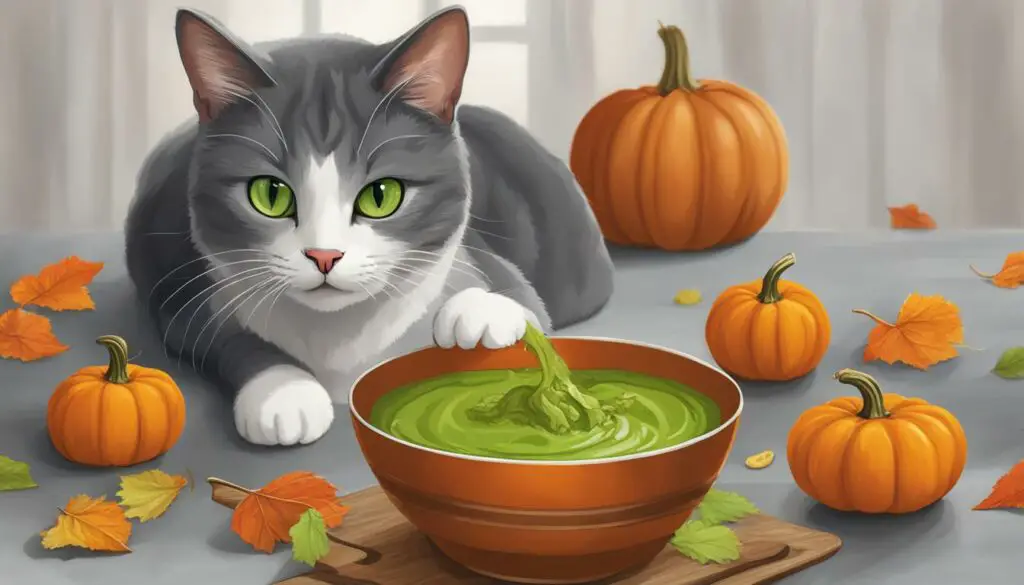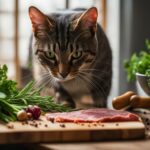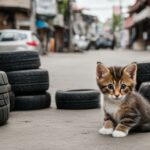Giving our feline friends a treat every now and then is a delightful way to show our love. With the fall season upon us, pumpkin-flavored treats have become a popular choice. But before we start sharing our pumpkin goodies with our beloved cats, it’s important to understand their preferences and the potential benefits or risks involved.
Key Takeaways:
- Cats can enjoy small amounts of plain, cooked, and unsweetened pumpkin puree as part of their diet.
- Pumpkin puree is a good source of fiber, which can aid in healthy digestion and bowel movements for cats.
- Avoid feeding cats pumpkin pie filling, as it often contains sugar, spices, and additives that can be harmful to their digestive system.
- When introducing pumpkin puree to cats, start with small portions and consult with a veterinarian for guidance.
- Remember to always prioritize moderation and consult with a professional before making any changes to your cat’s diet.
Why Pumpkin Pie Filling Is Not Suitable for Cats
When it comes to feeding your cat pumpkin, it’s important to steer clear of pumpkin pie filling. While pumpkin can be a healthy addition to a cat’s diet, the same cannot be said for its sugary, spiced, and additive-laden counterpart. Pumpkin pie filling often contains high levels of sugar, which can cause digestive issues in cats. Additionally, the spices used in pumpkin pie, such as nutmeg, can be toxic to felines and may lead to discomfort or other health problems.
Furthermore, the high fat content in pumpkin pie filling can pose a risk to your cat’s well-being. Cats have sensitive digestive systems, and consuming excessive amounts of fat can result in vomiting, diarrhea, or even pancreatitis. It’s essential to prioritize your cat’s health by avoiding pumpkin pie filling and opting for plain, cooked, and unsweetened pumpkin puree instead.
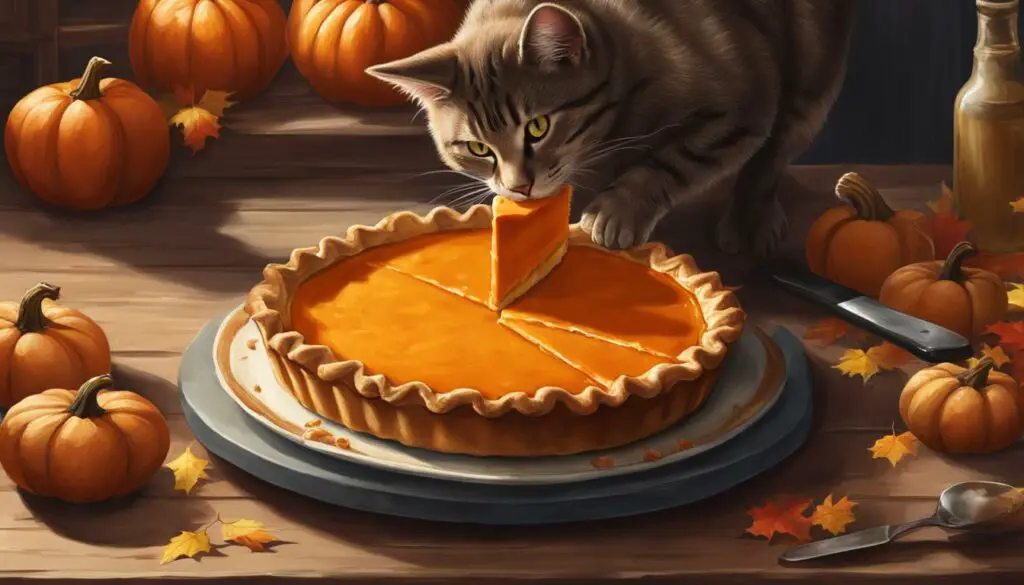
“Feeding cats pumpkin pie filling can lead to digestive issues, discomfort, and even toxicity.”
Potential Effects of Pumpkin Pie on Cats’ Health
Feeding cats pumpkin pie can have several negative effects on their health. The sugar in pumpkin pie can upset their stomach and lead to digestive issues. Spices like cinnamon and nutmeg commonly found in pumpkin pie can also cause discomfort and digestive upset in cats. Some spices can even be toxic to cats and may result in more severe health problems. It’s important to avoid feeding cats pumpkin pie and instead provide them with safe alternatives.
| Potential Health Risks of Feeding Cats Pumpkin Pie | Effects on Cats |
|---|---|
| Sugar content | Upset stomach, digestive issues |
| Spices like cinnamon and nutmeg | Discomfort, digestive upset |
| Toxic spices | Potential severe health problems |
“Feeding cats pumpkin pie can be detrimental to their health due to the sugar and spices it contains. The sugar content can lead to upset stomach and digestive issues, while spices like cinnamon and nutmeg can cause discomfort and digestive upset. Some spices may even be toxic to cats, posing more severe health risks. It is important to prioritize their well-being and provide them with safe alternatives.”
When it comes to feeding cats, it’s always best to opt for plain, cooked, and unsweetened pumpkin puree instead of pumpkin pie. Pumpkin puree contains beneficial fiber that can support cats’ digestion and promote healthy bowel movements. By avoiding pumpkin pie, cat owners can ensure that their furry friends are not exposed to unnecessary health risks. Remember, consultation with a veterinarian is always recommended before introducing any new food into a cat’s diet to ensure it is safe and appropriate for their individual needs.
Safe Alternatives to Pumpkin Pie Filling for Cats
When it comes to treating our feline friends to the flavors of fall, it’s important to find safe alternatives to pumpkin pie filling. While the filling itself can be harmful to cats due to its sugar, spices, and additives, there are healthier options that can still satisfy their taste buds and provide nutritional benefits.
One safe alternative is plain, cooked, and unsweetened pumpkin puree. This natural ingredient is rich in fiber, which can aid in digestion and promote healthy bowel movements for cats. It’s important to introduce pumpkin puree gradually into their diet to ensure it is well-tolerated by their digestive system.
Consulting with a veterinarian is always recommended before introducing any new food into a cat’s diet. They can provide guidance on the appropriate portion size based on the cat’s size, age, and specific dietary needs.
| Treat Options | Description |
|---|---|
| Cat-Specific Pumpkin Treats | These treats are specifically formulated for cats, ensuring they are safe and suitable for their digestive system. |
| Pumpkin-Flavored Cat Foods | Some cat food brands offer pumpkin-flavored options that provide the benefits of pumpkin in a convenient and balanced meal. |
By choosing these safe alternatives, we can indulge our cats in the flavors of pumpkin while prioritizing their health and well-being.
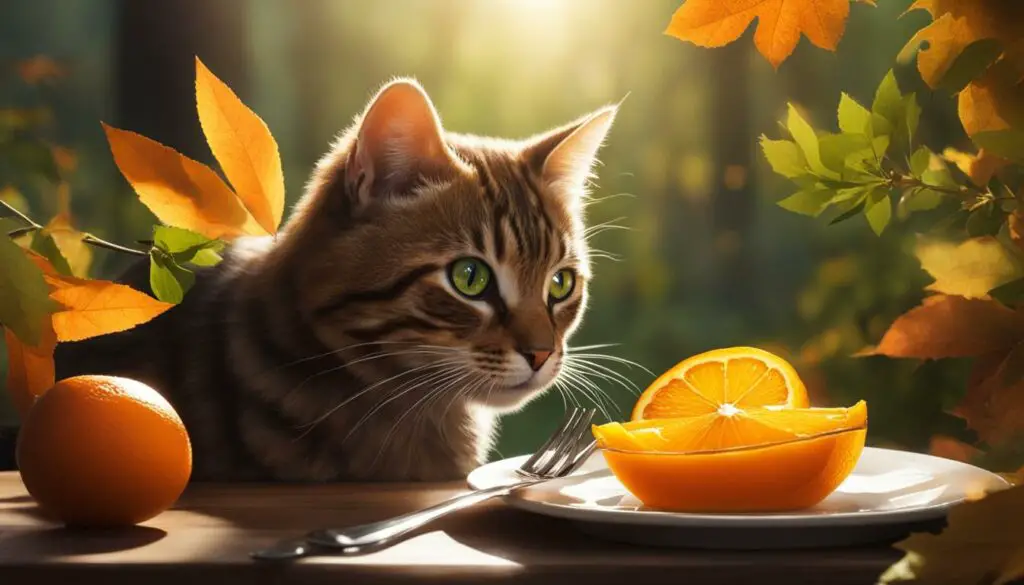
The Potential Risks of Pumpkin Pie Filling for Kittens
Kittens are curious and may be tempted to try pumpkin pie filling if given the chance. However, it is important to understand the potential risks associated with feeding pumpkin pie filling to kittens. Pumpkin pie filling typically contains sugar, spices, and additives that can be harmful to their developing systems. The high sugar content can disrupt their digestive process, leading to gastrointestinal issues such as diarrhea or upset stomach. Certain spices like nutmeg, commonly found in pumpkin pie, can be toxic to kittens and cause more severe health problems. Additionally, the high fat content in pumpkin pie filling can lead to gastrointestinal distress and discomfort.
Feeding pumpkin pie filling to kittens can also expose them to artificial additives that may not be safe for their consumption. These additives can potentially cause adverse reactions or sensitivities in kittens. It is best to avoid feeding pumpkin pie filling to kittens altogether and opt for plain, cooked, and unsweetened pumpkin puree if you wish to introduce pumpkin to their diet. Pumpkin puree without added sugars, spices, or additives can provide similar benefits without the potential risks.
“Feeding pumpkin pie filling to kittens can expose them to potential toxins, disrupt their digestion, and cause gastrointestinal distress.”
The Importance of a Balanced and Age-Appropriate Diet
When it comes to feeding kittens, it is crucial to provide them with a balanced and age-appropriate diet. Kittens have specific nutritional needs for growth and development, and their diet should consist primarily of their mother’s milk or a suitable kitten formula until they are around four to five weeks old. Once they start transitioning to solid food, it is important to offer them a specially formulated kitten food that meets their nutritional requirements. While small amounts of human food can be introduced into their diet, it should be done with caution and under the guidance of a veterinarian.
| Food | Feeding Guidelines |
|---|---|
| Kitten Formula | Feed exclusively until four to five weeks old, then gradually introduce solid food. |
| Kitten Food | Offer specially formulated kitten food that meets their nutritional needs. |
| Human Food | Offer small amounts of cooked lean meat, unseasoned scrambled eggs, small pieces of green salad or fruit, microwaved pumpkin or squash, and cooked grains as appropriate treats. |
Remember to monitor kittens for any adverse reactions or digestive issues when introducing new foods into their diet. If you have any concerns or questions about feeding kittens, consult with a veterinarian for personalized guidance and recommendations.
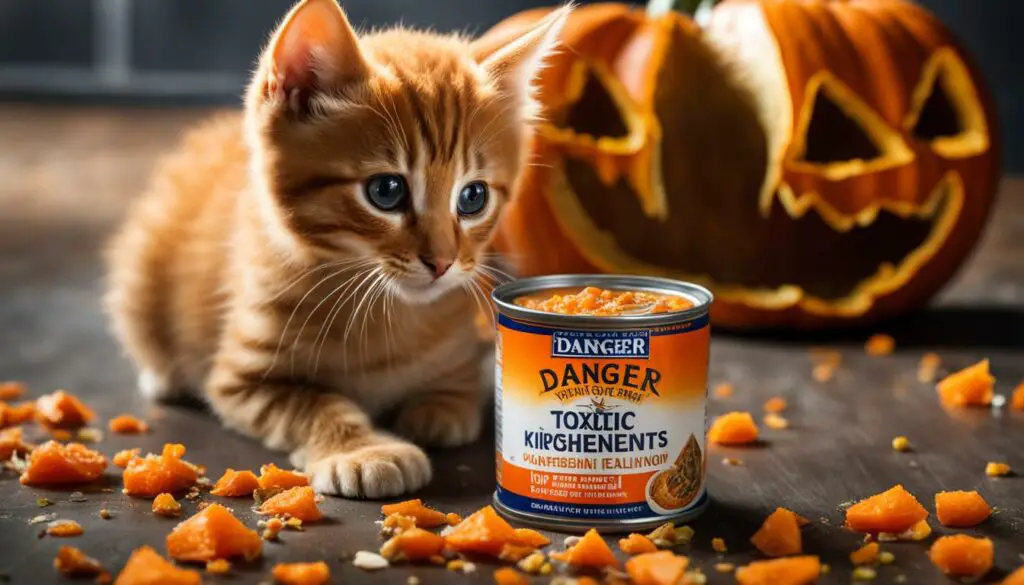
- Kittens should avoid pumpkin pie filling due to its sugar, spices, and additives.
- Pumpkin pie can disrupt kittens’ digestion and cause gastrointestinal distress.
- High fat content in pumpkin pie filling can lead to discomfort and upset stomach.
- Feeding plain, cooked, and unsweetened pumpkin puree is a safer alternative.
- It is important to provide kittens with a balanced and age-appropriate diet.
The Importance of Moderation with Pumpkin for Cats
When it comes to feeding cats pumpkin, moderation is key. While pumpkin can have many benefits for feline health, it’s important to avoid overfeeding it to cats. Consuming too much pumpkin can lead to digestive problems such as diarrhea or upset stomach due to its high fiber content.
Pumpkin is known for its ability to aid in digestion, thanks to its fiber content. It can help regulate bowel movements and prevent constipation in cats. However, introducing pumpkin to a cat’s diet should be done gradually to allow their digestive system to adjust. It’s recommended to consult with a veterinarian to determine the appropriate amount of pumpkin for your cat’s specific needs.
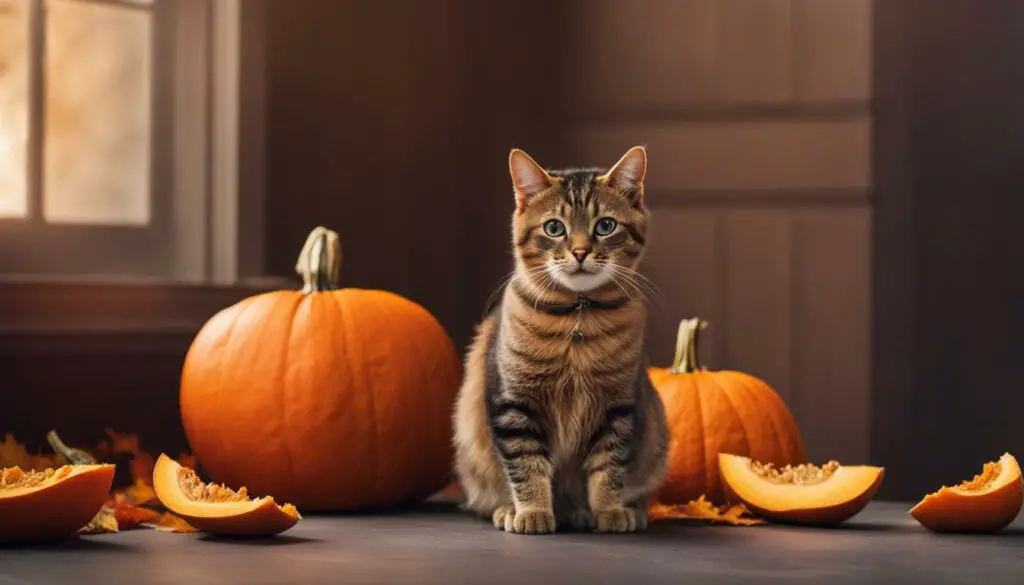
If you’re using pumpkin to address cat diarrhea, start with a small amount and monitor your cat’s condition closely. While pumpkin can be effective in relieving diarrhea, persistent or worsening symptoms may require veterinary guidance.
In summary, while pumpkin can be a beneficial addition to a cat’s diet, it’s crucial to use it in moderation. Too much pumpkin can cause digestive issues, so it’s essential to introduce it gradually and consult with a veterinarian to ensure your cat’s health and well-being.
The Compatibility of Cats and Pumpkin
Cats and pumpkin can be a harmonious combination when introduced appropriately in their diet. Pumpkin offers several benefits for cats, especially when it comes to their digestion and overall health. The high fiber content in pumpkin can help regulate bowel movements and support healthy digestion in cats, making it a valuable addition to their diet.
In addition to aiding digestion, pumpkin can also provide hydration for cats. Its high water content can help prevent urinary tract issues and promote a healthy urinary system. This is particularly important for cats, as they are prone to urinary tract problems. By incorporating pumpkin into their diet, cat owners can help support their feline friends’ urinary health.
It’s important to note that while pumpkin can be beneficial for cats, it should be introduced gradually and in moderation. Too much pumpkin can cause digestive upsets, such as diarrhea, due to its high fiber content. Consulting with a veterinarian can help determine the appropriate amount of pumpkin to incorporate into a cat’s diet based on their individual needs and health condition.
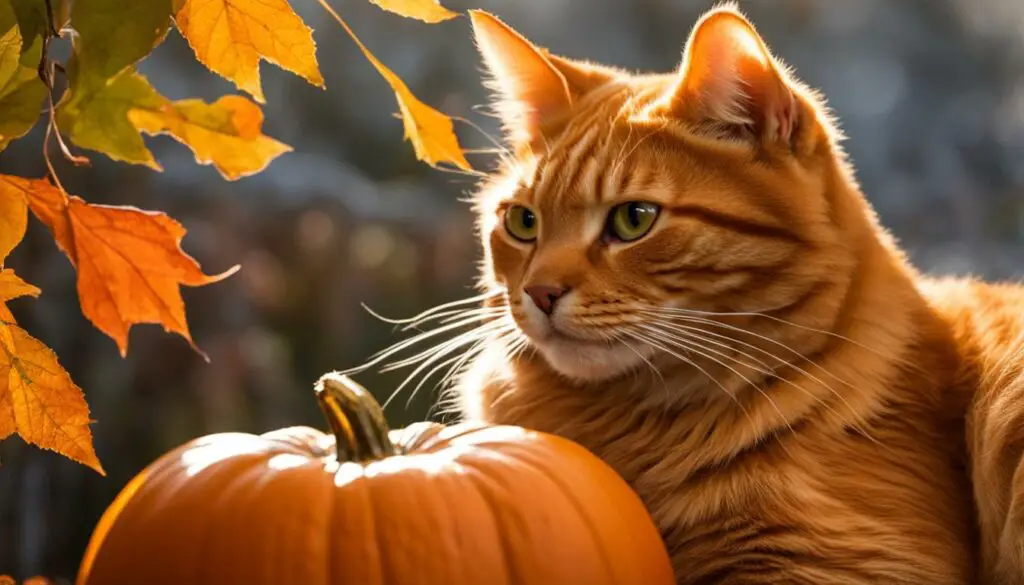
The Potential Benefits of Feeding Cats Pumpkin
- Promotes healthy digestion and bowel movements
- Provides hydration and supports urinary tract health
- Offers a natural source of fiber
- May help prevent hairballs
- Can be a tasty treat for cats
Overall, when introduced properly, pumpkin can be a beneficial addition to a cat’s diet. Its fiber content and hydrating properties can support healthy digestion and urinary tract health in cats. While moderation is key, incorporating pumpkin into a cat’s diet can provide them with a natural source of fiber and hydration. As always, consulting with a veterinarian is recommended to ensure the specific needs of the cat are met and to monitor for any adverse effects.
Can Raw or Cooked Meat Be Mixed with Pumpkin for Cats?
When it comes to feeding cats a balanced and nutritious diet, incorporating different ingredients can be beneficial. One such combination that many cat owners consider is mixing raw or cooked meat with pumpkin.
Raw meat can be a valuable source of protein for cats, providing essential amino acids and nutrients. However, it’s important to handle raw meat with care to prevent bacterial contamination. Cooked lean meats, such as chicken or turkey, are another option that can be mixed with pumpkin to create a well-rounded meal for cats. These cooked meats not only offer protein but are also easier for cats to digest.
Pumpkin, on the other hand, is rich in fiber and can help promote healthy digestion in cats. It can also provide hydration and support urinary tract health. When combined with raw or cooked meat, pumpkin adds an extra nutritional boost to the meal.
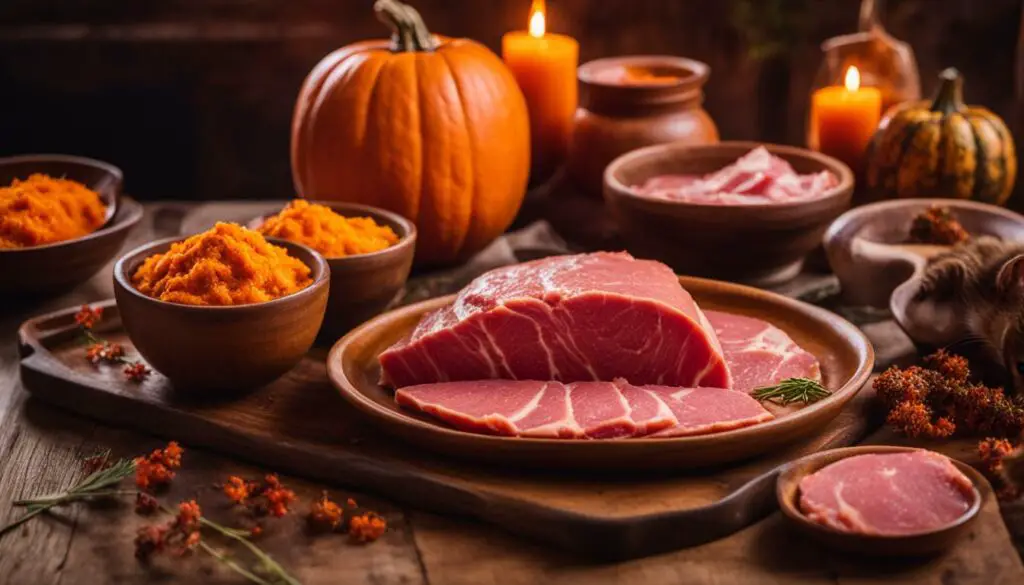
Creating a Balanced Diet for Cats
It’s important to note that while mixing raw or cooked meat with pumpkin can be a healthy addition to a cat’s diet, it should not be the sole component. Cats have specific nutritional requirements that can only be met with a balanced diet that includes a variety of ingredients. Consult with your veterinarian to determine the appropriate amount of meat and pumpkin to include in your cat’s meals based on their individual needs.
Remember, gradual introduction is key when introducing any new food to your cat’s diet. Monitor your cat’s reaction closely and be aware of any digestive issues or other adverse effects. If you have any concerns or questions, don’t hesitate to reach out to your veterinarian for guidance.
In conclusion, mixing raw or cooked meat with pumpkin can be a healthy and beneficial addition to a cat’s diet. It provides a source of protein and essential nutrients while also supporting digestion and urinary tract health. With proper handling and moderation, this combination can contribute to your cat’s overall well-being.
Fruits and Vegetables That Can Safely Be Added to a Cat’s Diet
When it comes to adding fruits and vegetables to a cat’s diet, there are a variety of safe options that can provide nutritional benefits and serve as delicious treats. While cats are primarily carnivorous, incorporating small amounts of fruits and vegetables into their meals can offer additional vitamins, minerals, and dietary fiber. However, it’s important to remember that each cat is unique, and what works for one may not work for another. Always introduce new foods gradually and monitor your cat’s response.
Safe Fruits for Cats:
- Apple
- Apricot
- Banana
- Blueberries
- Cranberries
- Strawberries
- Mango
- Pear
Safe Vegetables for Cats:
- Pumpkin
- Spinach
- Zucchini
- Sweet Potato
- Green Beans
- Cucumber
- Peas
- Celery
- Cauliflower
- Brussels Sprouts
These fruits and vegetables can be served in small, bite-sized pieces, either raw or cooked. However, always remember to remove any seeds, pits, or rinds that may be harmful to your cat. Additionally, it’s important to avoid using any seasonings, dressings, or oils that can be harmful or upset your cat’s digestive system.
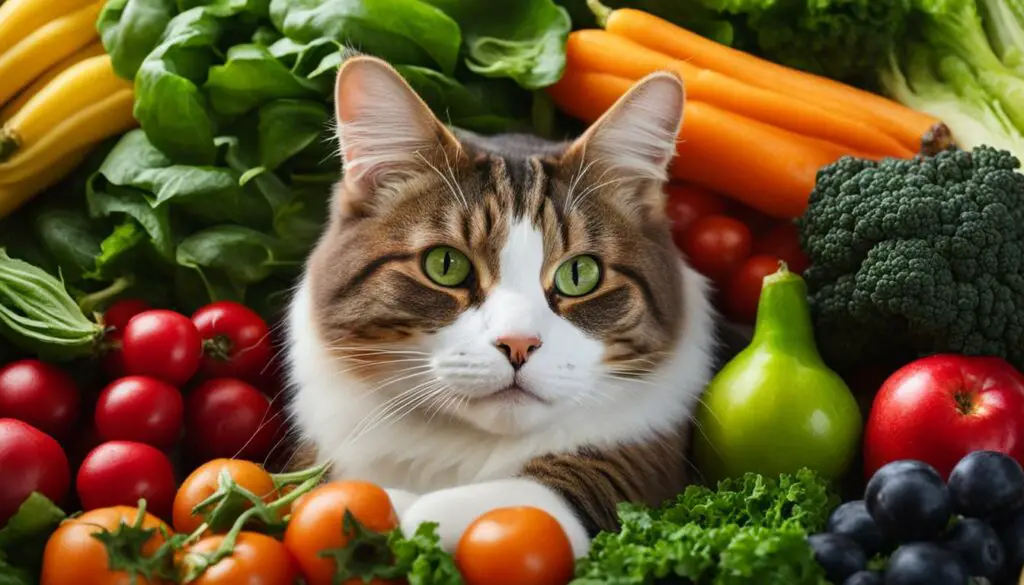
| Fruit | Nutritional Benefits |
|---|---|
| Apple | Rich in vitamin C and dietary fiber |
| Apricot | Contains vitamins A and C, as well as dietary fiber |
| Banana | Provides potassium, vitamin C, and vitamin B6 |
| Blueberries | Loaded with antioxidants and vitamin C |
| Cranberries | Support urinary tract health and provide vitamin C |
Remember to always consult with your veterinarian before making any significant changes to your cat’s diet. They can provide personalized advice based on your cat’s health, age, and specific dietary needs. By incorporating safe fruits and vegetables into their meals, you can provide your cat with a varied and nutritious diet that supports their overall well-being.
Fruits and Vegetables to Avoid Feeding to Cats
It’s important to be aware of the fruits and vegetables that should be avoided when feeding cats. Some fruits and vegetables can be toxic or harmful to felines, and it’s crucial to prioritize their health and well-being. Here are some fruits and vegetables that should not be given to cats:
- Grapes and raisins: These can cause severe kidney damage in cats.
- Figs and avocado: These fruits can be toxic to cats and should be avoided.
- Onion, garlic, scallion, shallot, leek, and chives: These root and stem vegetables can cause gastrointestinal distress, dehydration, and anemia in cats.
- Raw tomatoes and green potatoes: These should be avoided as they contain substances that can disrupt the feline digestive system.
It is important to ensure that any fruits or vegetables offered to cats are safe and well-tolerated. Always consult with a veterinarian to determine the best diet for your cat and to address any concerns or questions you may have.
“The safety and well-being of our feline companions should always be our top priority. By understanding which fruits and vegetables are safe for cats and which ones should be avoided, we can ensure that our furry friends stay healthy and happy.”
Table: Toxic Fruits and Vegetables for Cats
| Fruits | Vegetables |
|---|---|
| Grapes | Onion |
| Raisins | Garlic |
| Figs | Scallion |
| Avocado | Shallot |
| Leek | |
| Chives | |
It’s crucial to be cautious when introducing new foods to your cat’s diet, especially when it comes to fruits and vegetables. Always prioritize their safety and consult with a veterinarian for personalized guidance and recommendations. By making informed choices, we can provide the best possible care for our feline friends.
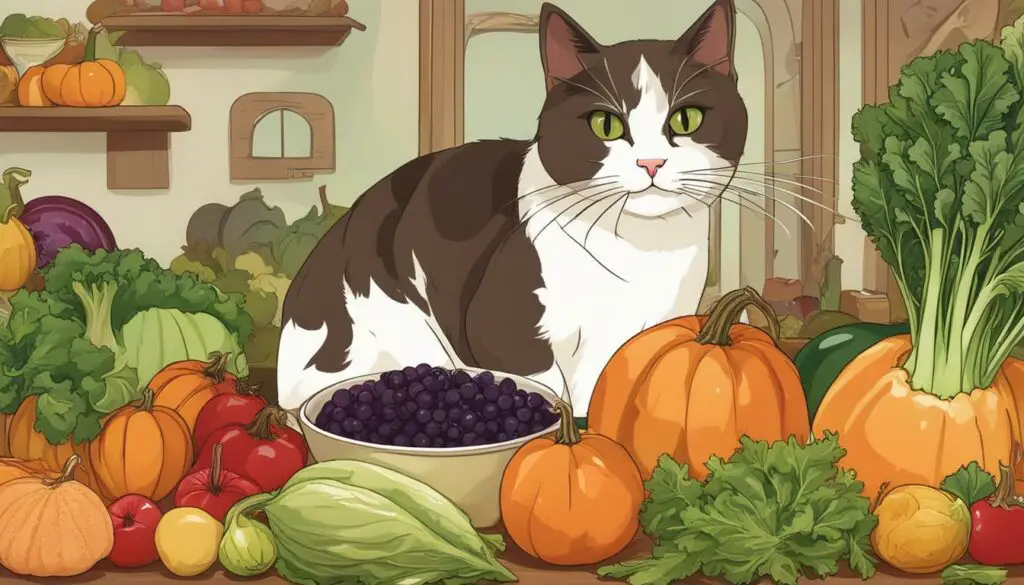
The Risks of Sharing Human Snacks with Cats
As much as we may want to treat our furry friends to a taste of our favorite snacks, it’s important to remember that not all human food is safe for cats. In fact, sharing snacks with cats can pose several risks to their health and well-being.
First and foremost, many human snacks are high in sugar or salt, which can be detrimental to a cat’s health. Cats have different dietary needs and are more sensitive to certain ingredients than humans. Foods that are high in sugar can lead to weight gain, diabetes, and dental problems in cats. Similarly, snacks that are high in salt can cause dehydration and kidney issues.
Furthermore, there are certain foods that are toxic to cats and should never be shared with them. These include chocolate, caffeine, alcohol, and any products containing xylitol, which is a common sweetener found in many sugar-free snacks. These substances can be highly toxic to cats and can cause symptoms ranging from gastrointestinal upset to seizures or even death.
While it may be tempting to share your favorite snacks with your feline companion, it’s important to prioritize their overall health and well-being.
In addition to the potential health risks, sharing human snacks with cats can also encourage begging and unhealthy eating behaviors. Cats are highly opportunistic and may quickly develop a preference for human food over their own balanced diet, leading to nutritional imbalances and obesity.
It’s important to prioritize a cat’s overall health and provide them with a balanced and appropriate diet specific to their nutritional needs. If you’re unsure about whether a particular food is safe for your cat, it’s always best to consult with a veterinarian before offering it to them.
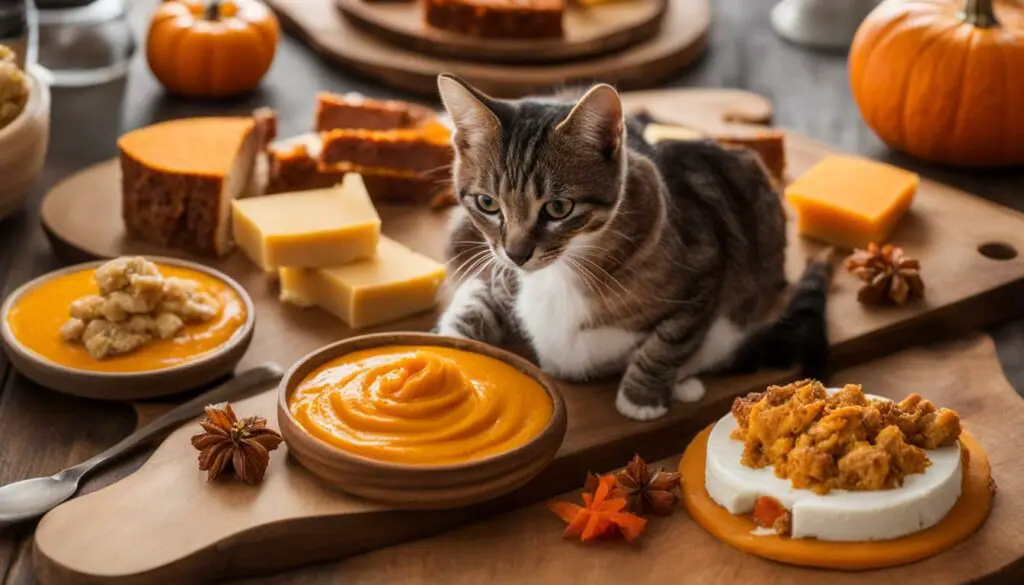
| Foods to Avoid Sharing with Cats | |
|---|---|
| Food Item | Risks to Cats |
| Chocolate | Can cause chocolate poisoning, leading to symptoms like vomiting, diarrhea, rapid breathing, increased heart rate, and even seizures. |
| Caffeine | Can cause caffeine poisoning, leading to agitation, rapid breathing, increased heart rate, tremors, and in severe cases, collapse or death. |
| Alcohol | Can cause alcohol poisoning, leading to symptoms like disorientation, loss of coordination, vomiting, seizures, respiratory distress, and even coma or death. |
| Xylitol | Can cause insulin release in cats, leading to low blood sugar levels, which can result in symptoms like vomiting, loss of coordination, seizures, and in severe cases, liver failure. |
While it may be tempting to share your favorite snacks with your feline companion, it’s important to prioritize their overall health and well-being. Stick to a balanced and appropriate diet for your cat, and consult with a veterinarian if you have any concerns or questions about their nutritional needs.
Feeding Human Food to Kittens
As kittens begin to transition from their mother’s milk or kitten formula to solid food, it is natural for pet owners to wonder if they can introduce human food into their diet. While small amounts of human food can be offered to kittens, it is important to choose safe options that provide the necessary nutrients for their growth and development.
Table: Human Food Options for Kittens
| Food | Description |
|---|---|
| Cooked Lean Meat | Chicken or turkey can be cooked and shredded into small pieces to provide kittens with a source of animal protein. |
| Unseasoned Scrambled Eggs | Scrambled eggs can be cooked without salt or seasonings and offered to kittens as a protein-rich treat. |
| Bits of Green Salad or Fruit | Small, bite-sized pieces of lettuce or fruit like apple or banana can be given to kittens as a source of vitamins and fiber. |
| Microwaved Pumpkin or Squash | Pumpkin or squash can be cooked in the microwave and mashed into a soft consistency for kittens to enjoy. |
| Small Doses of Cooked Grains | Cooked grains like rice or oatmeal can be given sparingly to kittens, providing them with carbohydrates for energy. |
When introducing human food to kittens, it is important to monitor their reactions and ensure they tolerate the new additions well. Kittens have specific nutritional requirements, and human food should supplement their diet rather than replace it entirely. For a balanced and healthy diet, it is recommended to consult with a veterinarian who can provide guidance on appropriate portion sizes and frequency of offering human food to kittens.
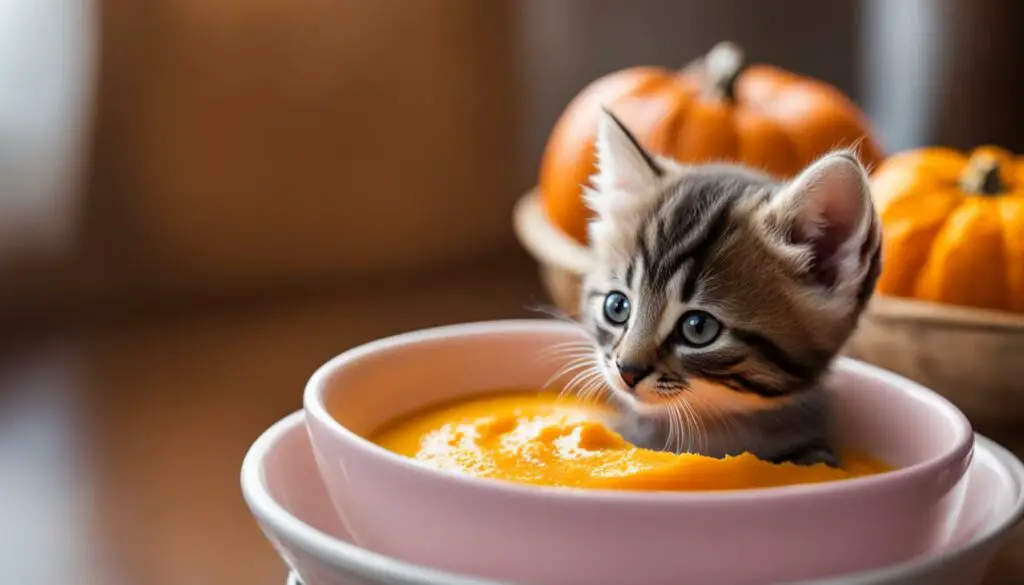
The Dangers of Pica Syndrome in Cats
One behavioral issue that can pose serious risks to cats is Pica Syndrome. This condition involves cats consuming non-food items, such as plastic, carpet, soil, rocks, or paper. Pica Syndrome can be caused by underlying health conditions, psychological setbacks, or nutritional deficiencies. It is important to address this behavior as it can lead to dental issues, abdominal obstruction, and exposure to toxins.
When a cat exhibits signs of Pica Syndrome, it is crucial to keep non-food items out of their reach to prevent further ingestion. Consulting with a veterinarian or behavioral therapist is recommended to understand the underlying cause and develop an appropriate treatment plan. They may suggest behavior modification techniques, environmental enrichment, or dietary adjustments to address the cat’s specific needs.
Identifying and addressing the root cause of Pica Syndrome is vital for the well-being of cats. By creating a safe and enriched environment, providing appropriate mental and physical stimulation, and ensuring a balanced and nutritious diet, cat owners can help prevent and manage the risks associated with this behavioral condition.
| Risks of Pica Syndrome in Cats | Prevention and Management |
|---|---|
| Dental Issues: Ingesting non-food items can lead to dental damage and oral injuries. | Safe Environment: Keep non-food items out of the cat’s reach to prevent ingestion. |
| Abdominal Obstruction: If a cat swallows large or indigestible objects, it may result in a blockage in the digestive system. | Behavior Modification: Consult with a veterinarian or behavioral therapist to develop strategies for modifying the cat’s behavior. |
| Toxin Exposure: Consuming non-food items can expose cats to toxins, which can lead to various health problems. | Environmental Enrichment: Provide mental and physical stimulation to keep cats engaged and reduce the likelihood of engaging in pica behavior. |
| Dietary Adjustments: Ensure the cat’s diet is balanced and meets their nutritional needs to prevent nutritional deficiencies. |
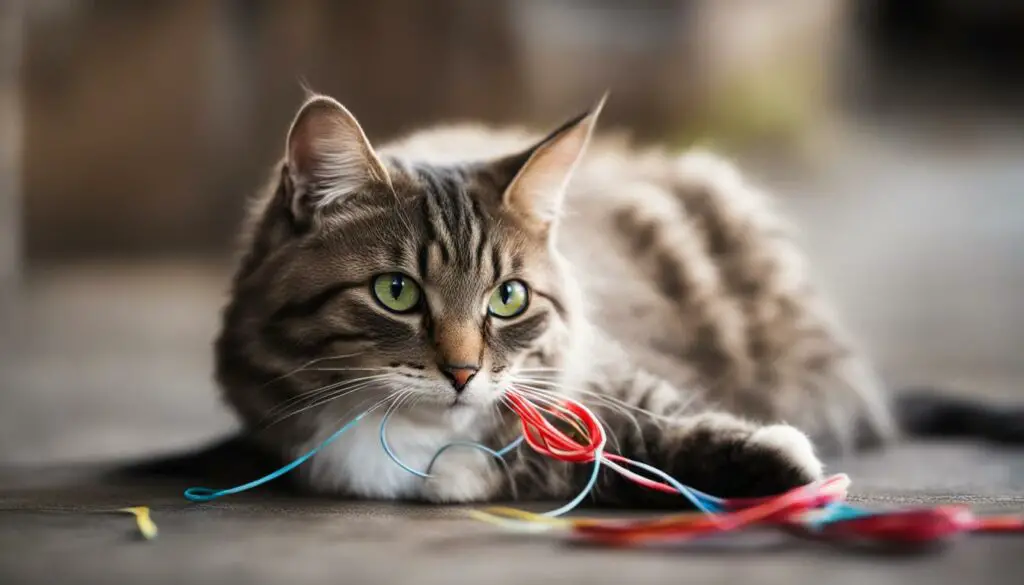
Remember, it’s important to seek professional guidance when dealing with Pica Syndrome in cats. A veterinarian or behavioral therapist can provide the necessary expertise to address this behavior and improve the overall well-being of the affected cat.
Choosing the Best Diet for Cats
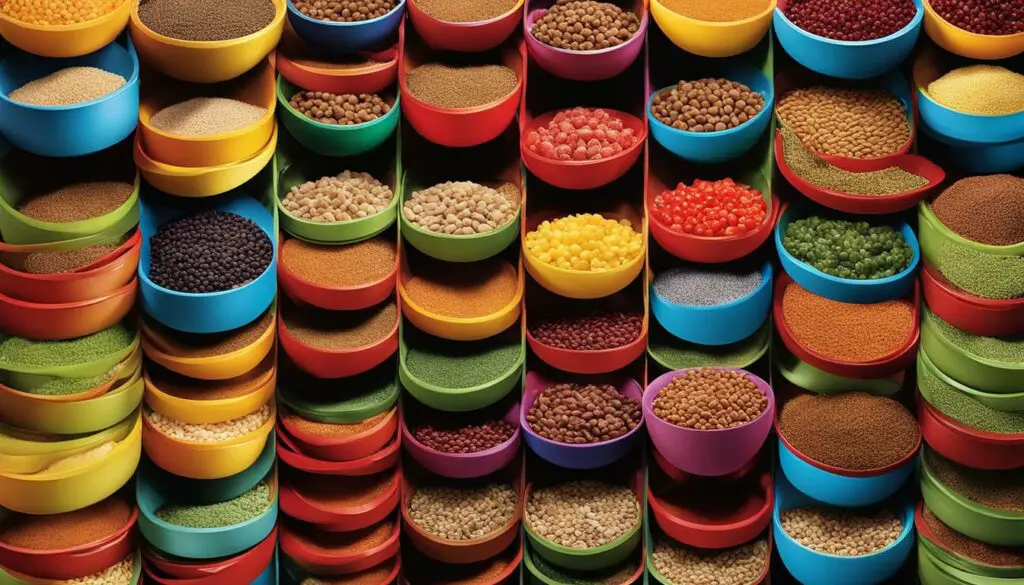
When it comes to choosing the best diet for your cat, it’s essential to consider their nutritional needs and overall health. Cats are obligate carnivores, which means their diets should primarily consist of animal-based proteins to ensure they receive the necessary nutrients for optimal health.
Animal-based proteins, such as those found in meat, are more easily absorbed by cats’ bodies and provide essential amino acids for muscle tone, organ health, and antibody production. Taurine, an amino acid compound found in proteins from seafood and meat, is particularly important for cats’ eye, heart, and reproductive health.
In addition to proteins, cats also require suitable vitamins and minerals in their diet. Consulting with a veterinarian or nutritionist can help determine the best diet for your cat’s individual needs and ensure they receive a well-balanced and nutritious meal plan.
Key Considerations for Cat Nutrition Guidelines
When selecting cat food, consider the following guidelines:
- Look for cat foods that list high-quality animal proteins, such as chicken, turkey, or fish, as the primary ingredients.
- Avoid foods that contain fillers, artificial preservatives, and excessive carbohydrates.
- Cats have low thirst drives, so providing wet food or ensuring fresh water is always available is important for proper hydration.
- Take into account your cat’s age, weight, and any specific dietary requirements or health conditions they may have.
“Choosing the right diet for your cat is crucial for their overall health and well-being. Cats thrive on high-quality, animal-based proteins and require proper hydration. Consulting with a veterinarian can help ensure your cat’s nutritional needs are met and that you choose the best diet for their specific requirements.”
| Dietary Component | Why It’s Important |
|---|---|
| Animal-based Proteins | Essential for muscle tone, organ health, and antibody production |
| Taurine | Crucial for eye, heart, and reproductive health |
| Vitamins and Minerals | Support overall health and immune function |
| Avoid Fillers and Carbohydrates | Focus on high-quality ingredients and avoid unnecessary additives |
| Proper Hydration | Provide wet food or ensure fresh water is always available to prevent dehydration |
Conclusion
After exploring the topic of cats and pumpkin puree, it is clear that while cats may enjoy the taste of pumpkin pie filling, it is not suitable for their health. The sugars, spices, and additives in pumpkin pie filling can lead to digestive upset and potential toxicity in cats. However, plain, cooked, and unsweetened pumpkin puree can be a healthy addition to a cat’s diet in moderation.
Pumpkin puree can provide several benefits for cats, including fiber, hydration, and support for urinary tract health. It can help with digestion and promote healthy bowel movements in cats. It is important to introduce pumpkin gradually and in moderation to ensure it is well-tolerated by the cat’s digestive system. It should be seen as a supplement to a balanced cat diet rather than a standalone food.
As with any dietary change, it is always recommended to consult with a veterinarian to ensure the specific needs of the cat are being met. A veterinarian can provide guidance on the appropriate amount of pumpkin puree to include in a cat’s diet and monitor for any adverse effects. By taking these steps, cat owners can safely incorporate pumpkin puree into their pet’s diet and provide them with a nutritious and enjoyable treat.
In conclusion, while cats shouldn’t be fed pumpkin pie filling, they can certainly enjoy the benefits of plain, cooked, and unsweetened pumpkin puree. By understanding the potential risks and benefits of feeding cats pumpkin puree, cat owners can make informed decisions and contribute to their pet’s overall health and well-being.
FAQ
Do cats like pumpkin puree?
Some cats may enjoy the taste of pumpkin puree, while others may not show much interest. It ultimately depends on the individual cat’s preference.
Why is pumpkin pie filling not suitable for cats?
Pumpkin pie filling contains sugar, spices, and additives that can be harmful to cats’ digestive systems. It is best to avoid feeding cats pumpkin pie filling to prevent potential health issues.
What are the potential effects of pumpkin pie on cats’ health?
Pumpkin pie can cause digestive issues, discomfort, and even toxicity in cats due to the sugar, spices, and high fat content it contains. It is best to avoid feeding pumpkin pie to cats.
What are the safe alternatives to pumpkin pie filling for cats?
Plain, cooked, and unsweetened pumpkin puree can be a healthy addition to a cat’s diet in small amounts. There are also cat-specific pumpkin treats or specially formulated pumpkin-flavored cat foods available as alternatives.
Why is pumpkin pie filling not suitable for kittens?
Pumpkin pie filling contains sugar and spices that can harm kittens’ delicate systems. It is best to avoid feeding pumpkin pie filling to kittens and offer plain, cooked, and unsweetened pumpkin puree instead.
Why is moderation important with pumpkin for cats?
Feeding cats too much pumpkin can cause digestive problems such as diarrhea or upset stomach due to its high fiber content. It is important to introduce pumpkin gradually and in moderation to avoid these issues.
Are cats compatible with pumpkin?
Cats can benefit from the addition of plain, cooked, and unsweetened pumpkin puree in their diet due to its fiber content. However, it is important to consult with a veterinarian to ensure it is suitable for the specific needs of the cat.
Can raw or cooked meat be mixed with pumpkin for cats?
Yes, cooked, lean meats such as chicken or turkey can be mixed with pumpkin to create a balanced and nutritious meal for cats. Raw meat should be handled with caution to avoid bacterial contamination.
What fruits and vegetables can be safely added to a cat’s diet?
Safe fruits for cats include apple, apricot, banana, blueberries, cranberries, strawberries, mango, and pear. Safe vegetables for cats include pumpkin, spinach, zucchini, sweet potato, green beans, cucumber, peas, celery, cauliflower, and Brussels sprouts.
Which fruits and vegetables should be avoided when feeding cats?
Grapes, raisins, figs, avocado, onion, garlic, scallion, shallot, leek, chives, raw tomatoes, and green potatoes should be avoided when feeding cats as they can be toxic or cause gastrointestinal distress.
What are the risks of sharing human snacks with cats?
Most human snacks are high in sugar or salt, which can be detrimental to a cat’s health. Cats should not be given snacks containing caffeine, alcohol, dairy, raw bread dough, xylitol, or any ingredients that may be toxic or harmful to their digestive system.
Can human food be fed to kittens?
Kittens should primarily be fed their mother’s milk or kitten formula until they are four to five weeks old. Once they start transitioning to solid food, small amounts of cooked lean meat, unseasoned scrambled eggs, bits of green salad or fruit, microwaved pumpkin or squash, and small doses of cooked grains can be introduced.
What are the dangers of pica syndrome in cats?
Pica syndrome is a condition where cats eat non-food items, which can lead to dental issues, abdominal obstruction, and exposure to toxins. It is important to keep non-food items out of a cat’s reach and seek veterinary or behavioral therapy assistance if pica syndrome is observed.
How can I choose the best diet for my cat?
An ideal cat diet should consist of animal-based proteins, essential vitamins and minerals, and a balance of meat, bone, and organ components. It is recommended to consult with a veterinarian or nutritionist to determine the best diet for your cat’s individual needs.
Conclusions on cats and pumpkin diet?
Feeding cats plain, cooked, and unsweetened pumpkin puree in moderation can provide benefits such as fiber, hydration, and support for urinary tract health. However, it is important to consult with a veterinarian to ensure the specific needs of the cat are met and to monitor for any adverse effects.

